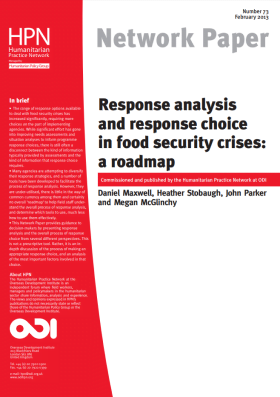Response Analysis and Response Choice in Food Security Crises: A roadmap
The term ‘response analysis’ implies that response choices are made solely on the basis of evidence and analysis. However, many factors contribute to how agencies select a response, and ‘response choice’ does not always involve an evidence-based, analytical process. Recent research by The Feinstein International Center at Tufts University suggests that response choices are also driven by the capacity and organisational ethos of the implementing agency, the personal experience of programme staff and a range of external factors, including donor resources and policy, government policy in the recipient country, media and political influences, the costs of reporting and compliance associated with different resources, the capacity of partner organisations and considerations (or assumptions) about the risks associated with different responses. Sometimes the complexity of the context can severely constrain response options.
This Network Paper provides guidance to decision-makers by presenting response analysis and the overall process of response choice from several different perspectives. This is not a prescriptive tool. Rather, it is an in-depth discussion of the process of making an appropriate response choice, and an analysis of the most important factors involved in that choice.
The paper is in four parts. The first section reviews definitions and suggests a roadmap of the decision-making process about response choices. The second section explores the factors that decision-makers take into consideration when making response choices. The third part examines the constraints to evidence-based decision making and outlines good practice in managing them. The fourth section examines existing response analysis tools, explores the reasons why they are often not utilised and maps existing tools to the specific types of decisions for which they are designed. The final sections of the paper outline the challenges of incorporating response analysis information into assessments, and raise some questions for future practice.



